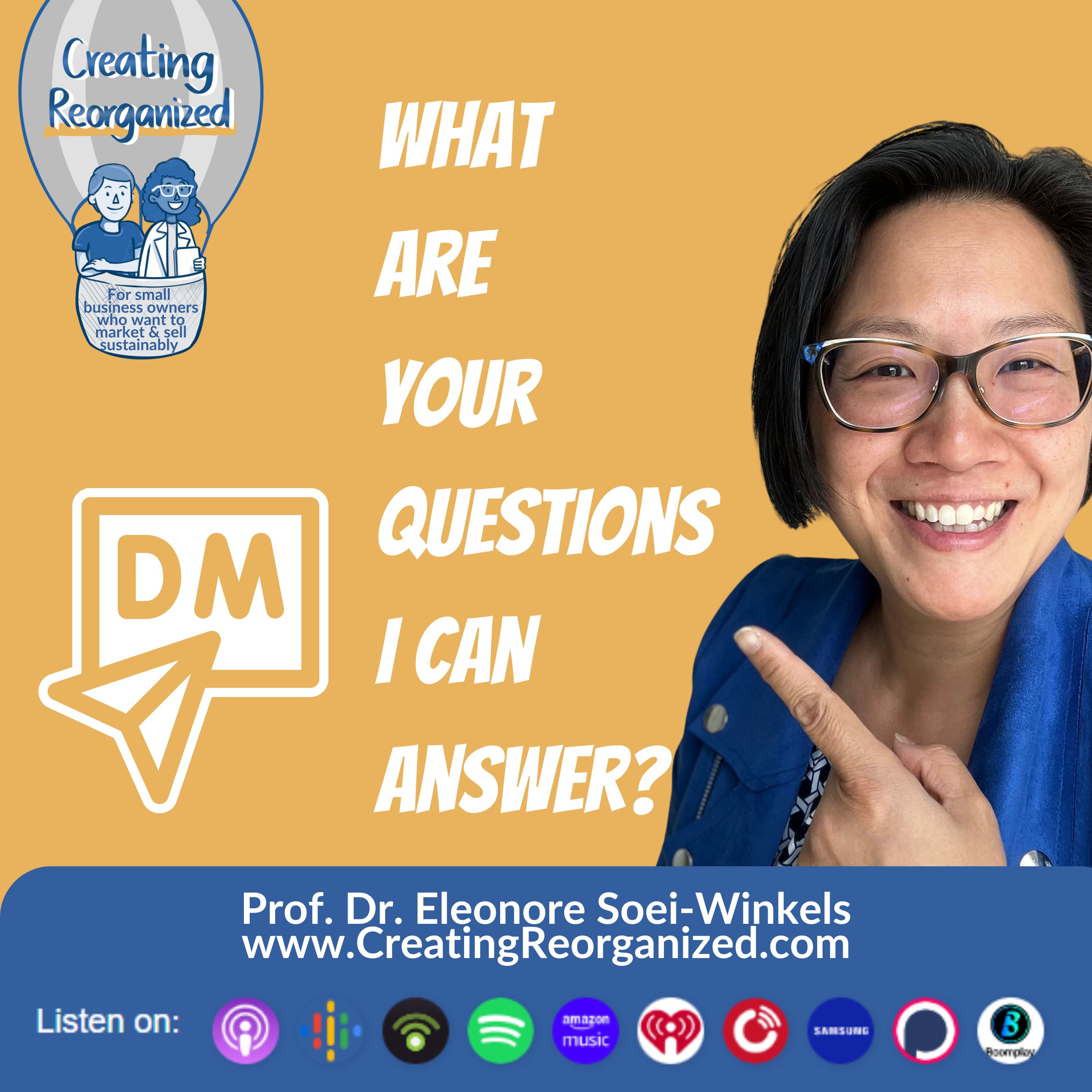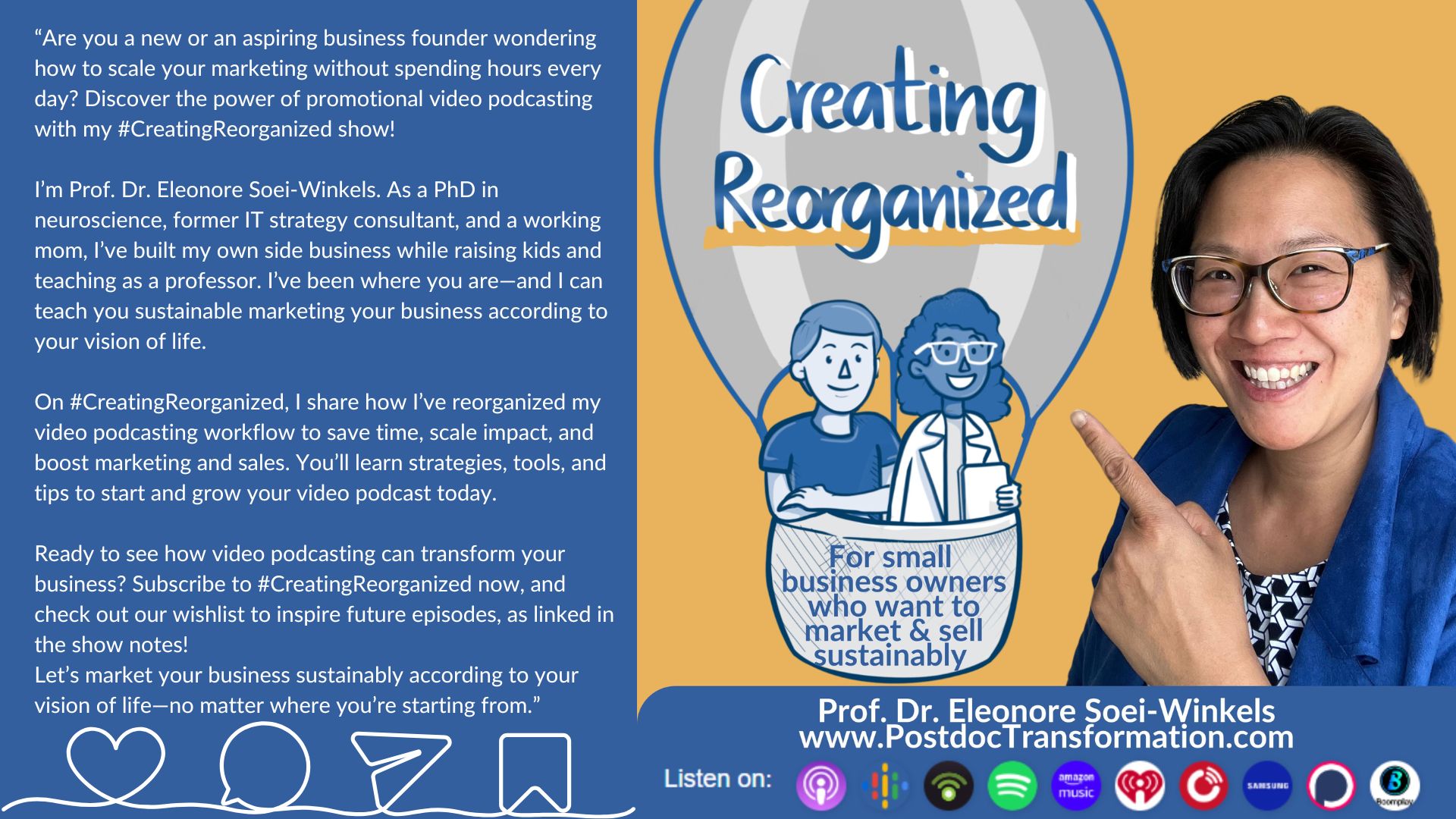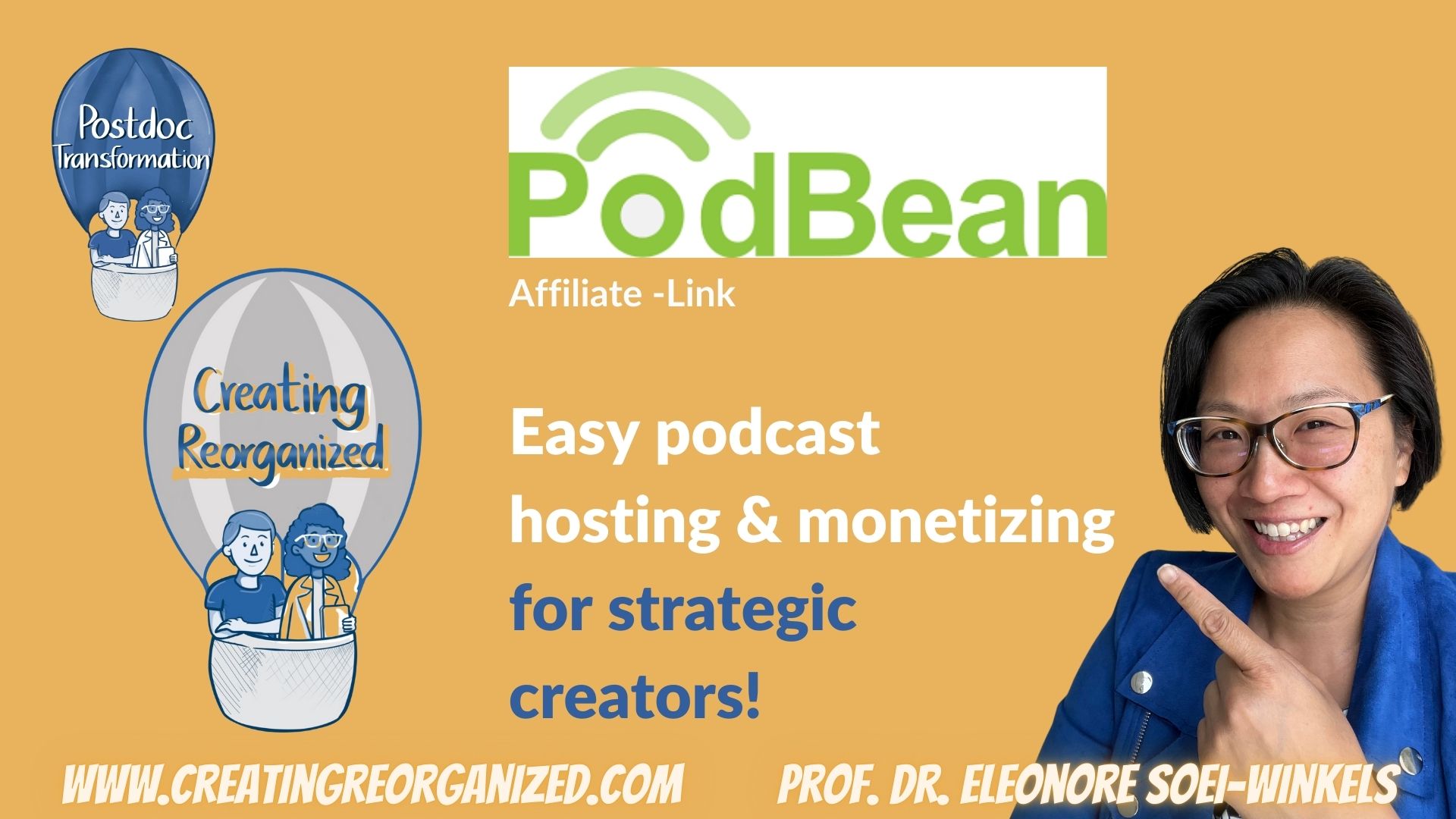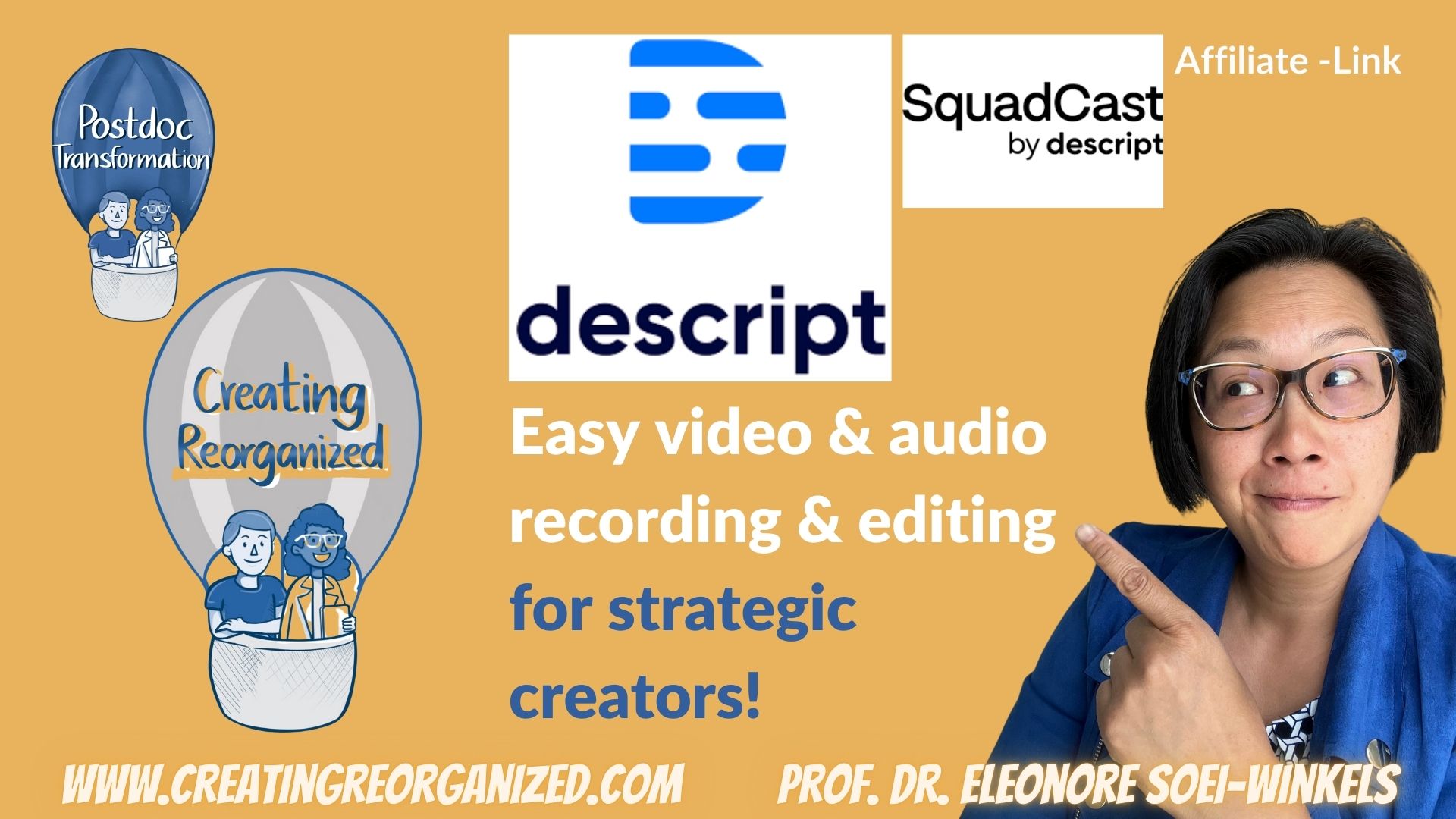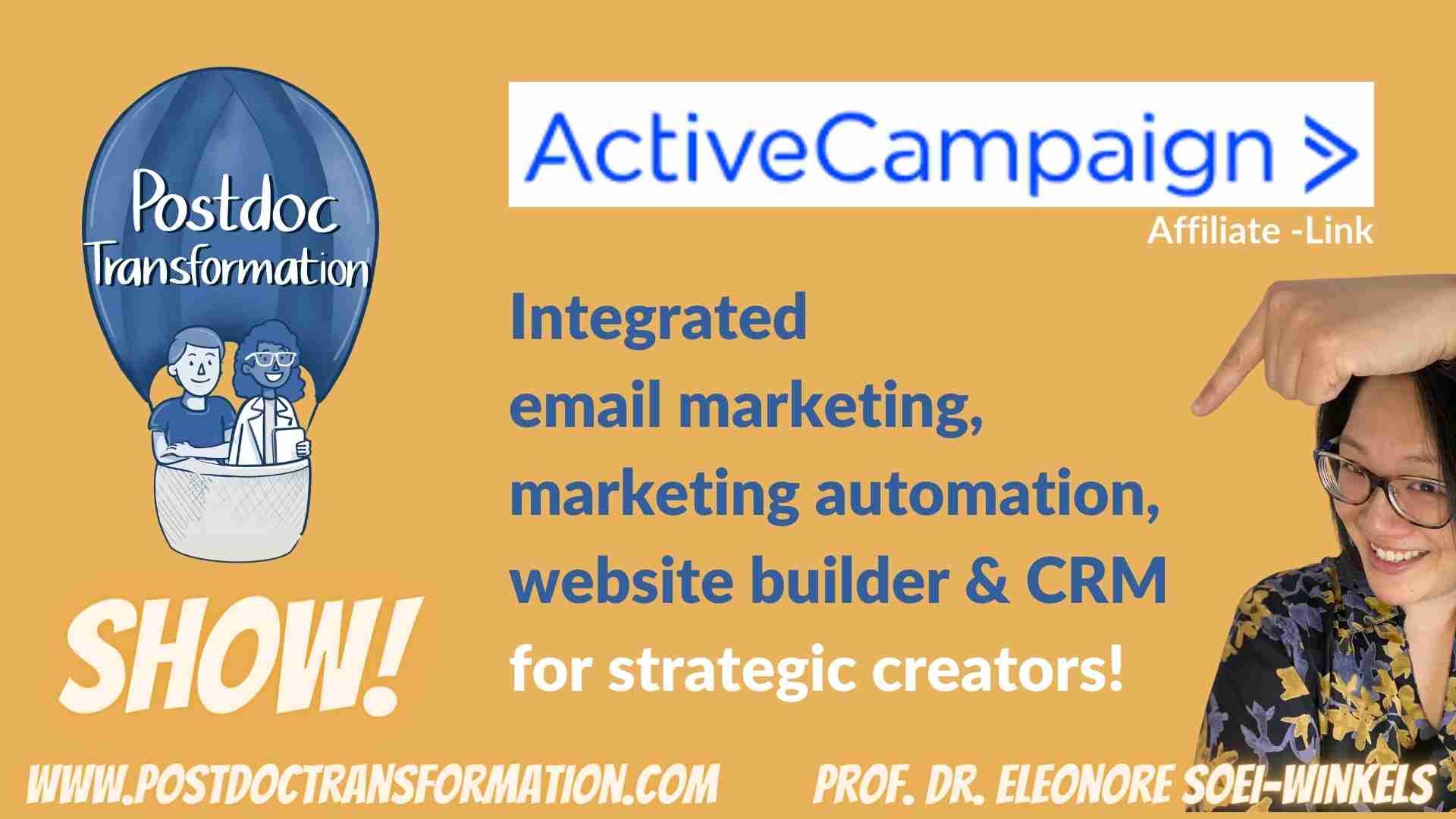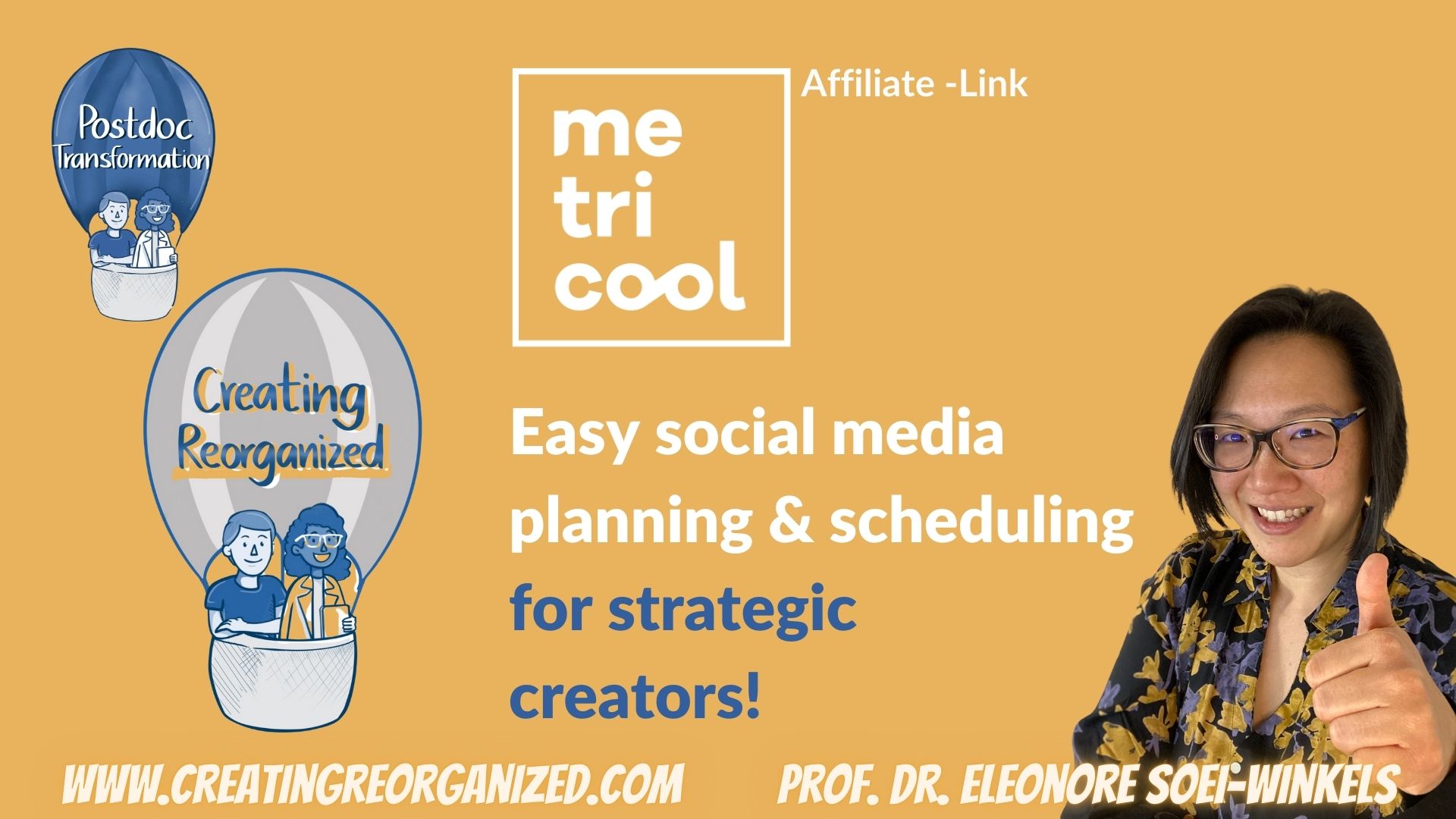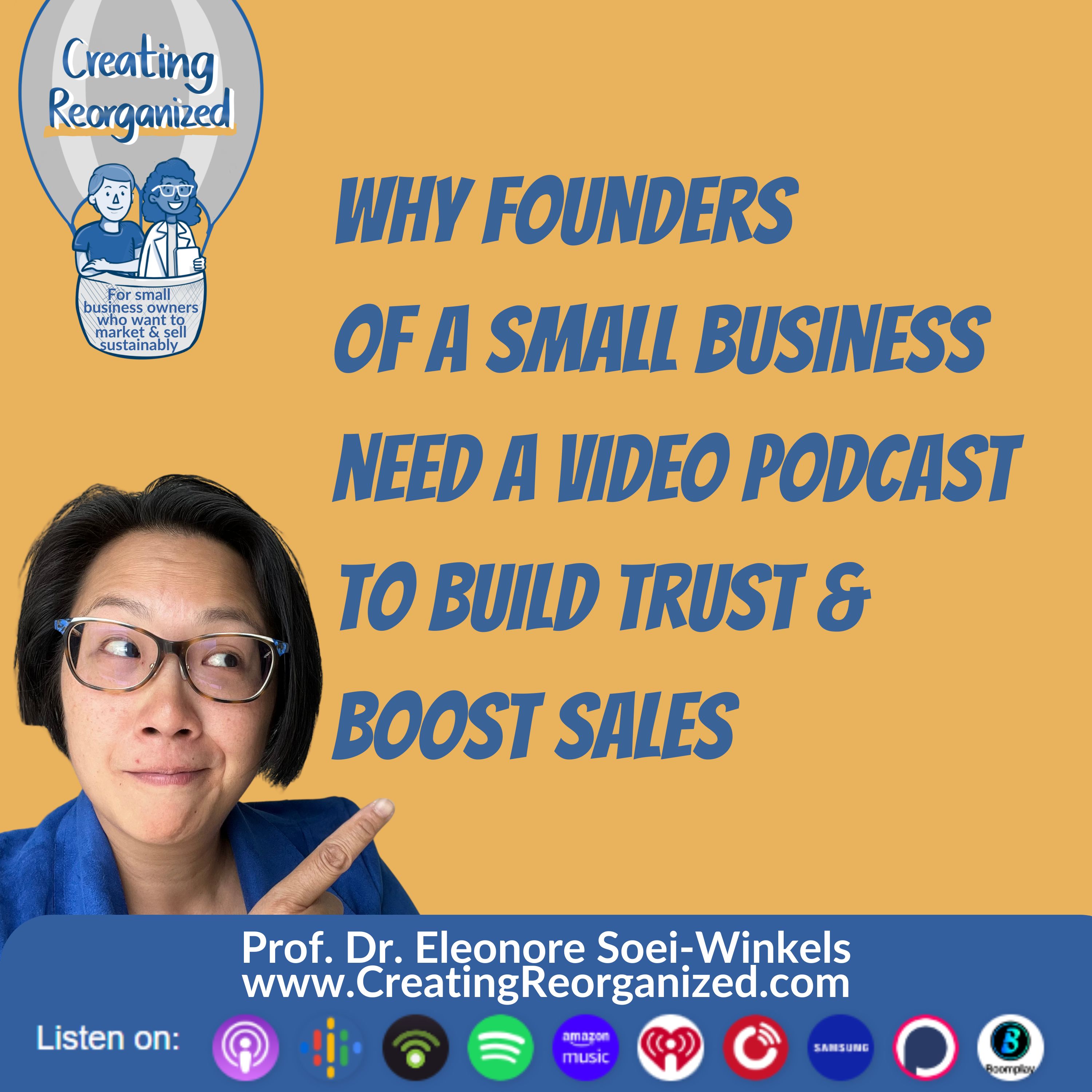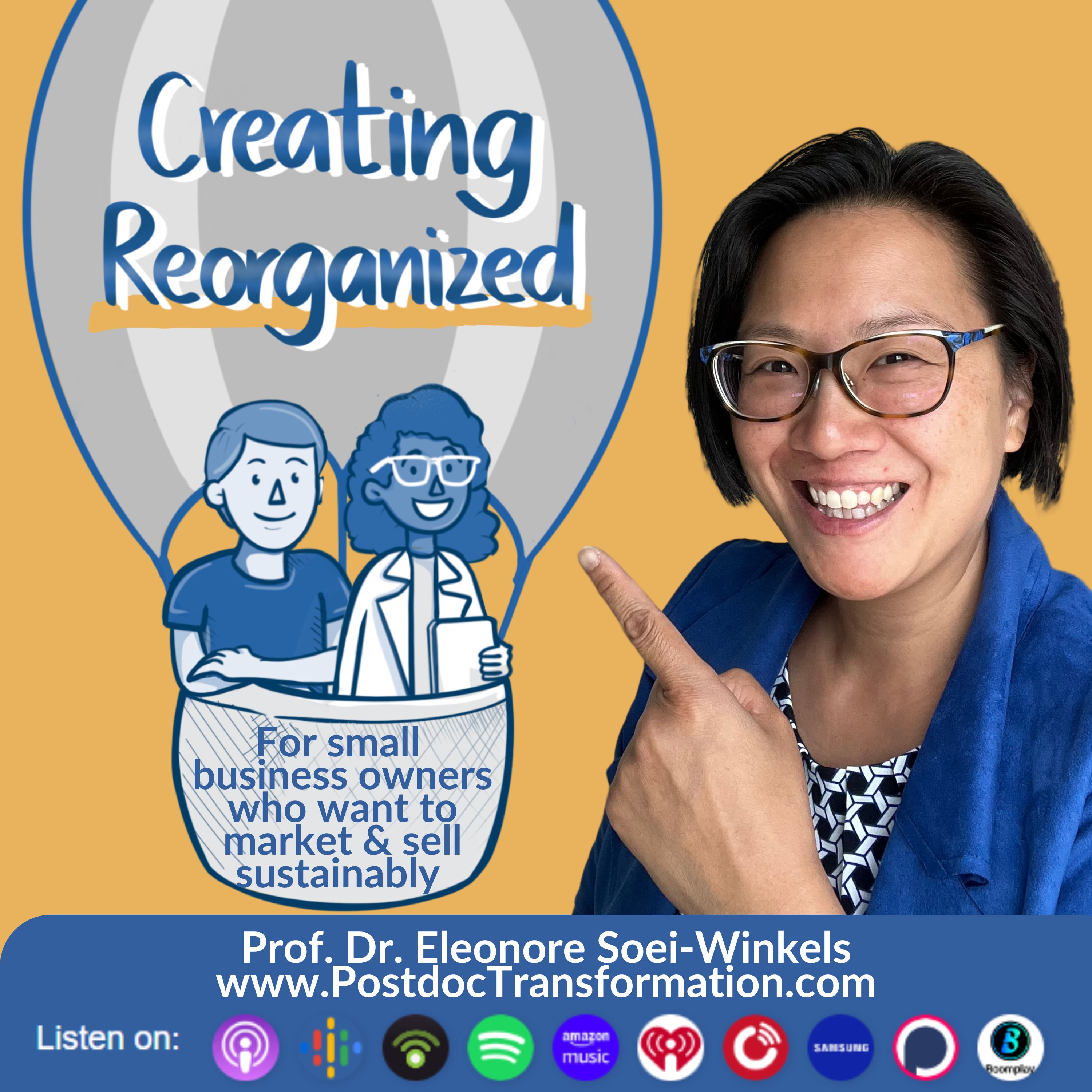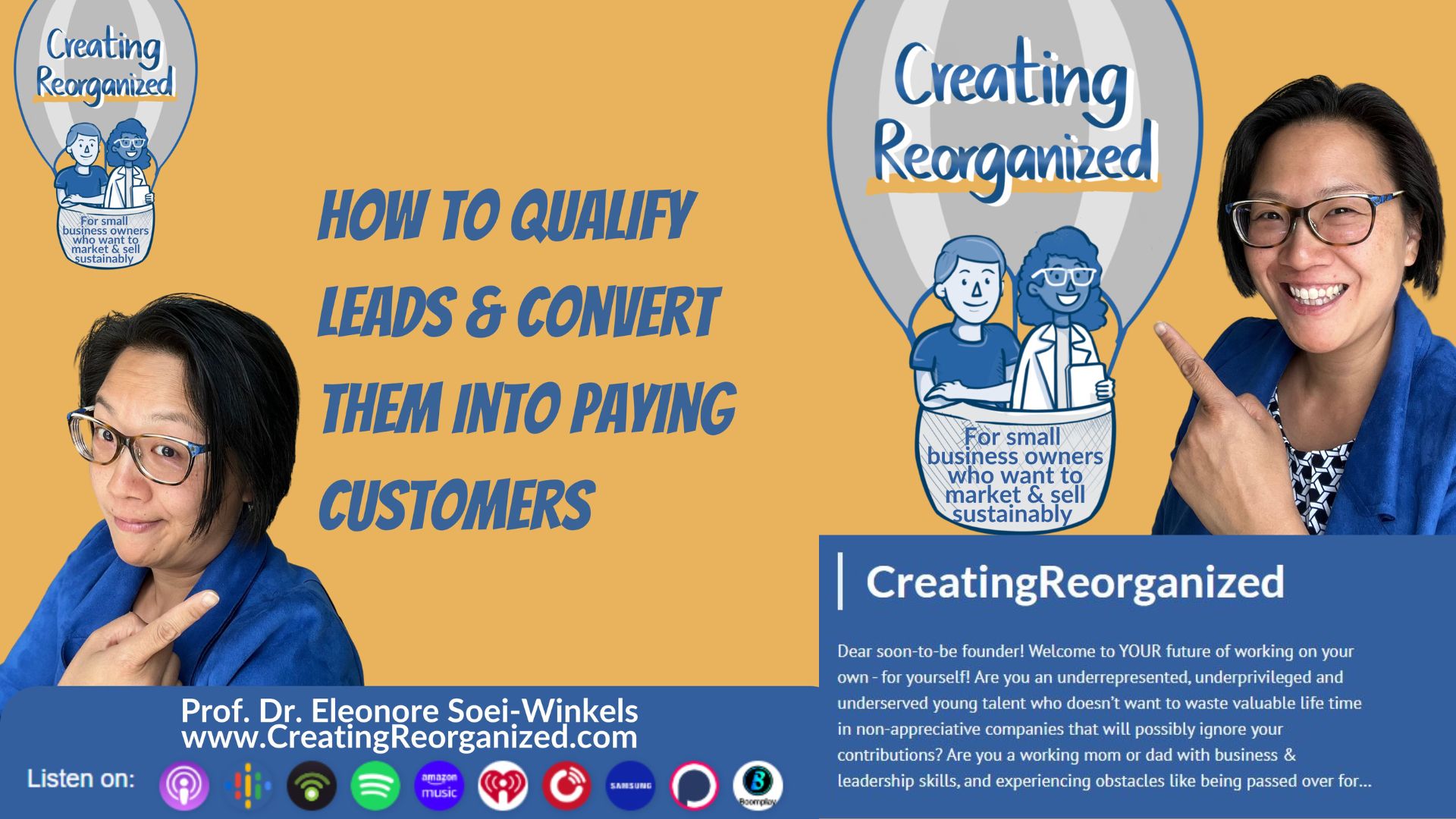
How to qualify leads and convert them into paying customers,
CreatingReorganized show
In this episode of the CreatingReorganized show, Professor Dr. Eleonore Soei Winkels discusses how small business owners can effectively use video podcasts for social media marketing to convert listeners into paying customers. As a former IT strategy consultant and current psychology professor, podcast host and producer of the PostdocTransformation show, she outlines her own experience balancing professional work with family life and how she uses technology to streamline her business tasks. With practical insights into qualifying leads, creating engaging content, and using tools like Podbean, Descript, Typeform, ActiveCampaign, Thinkific and Metricool, she offers a comprehensive guide to scaling marketing efforts while maintaining a work-life balance. The episode emphasizes the importance of authenticity, consistency, storytelling, and strategic automation in building trust and boosting sales.
If you are a new or aspiring founder of your small business and have no time to waste, or really struggle to do your social media marketing, you will enjoy our #CreatingReorganized show!
In my day job as a psychology professor I teach my bachelor and master students in real life, how to reorganize processes in a goal-directed and future-proof way in companies. That’s what I had done for a living as a former IT strategy consultant.
For my own career coaching business on the side, I can only dedicate a fraction of my time – because I prioritize care work for my little children. I face the same or similar challenges like all small business owners. So, I applied all my experience and knowledge to create my other video podcast #PostdocTransformation to streamline my social media marketing and to boost sales of my coaching, e-courses and affiliate products or services.
I strategically capitalize on professional tools to scale my impact according to my vision of life.
Listen and subscribe to this #CreatingReorganized show, so you will learn to do the same for your own business, to build the know, like and trust factor and to boost sales of your services or products!
Please also ask your business-specific questions, because for season 2, I envision interview episodes with aspiring and new founders like you, if you want to get your #CreatingReorganized according to your vision of life!
Hi, CreatingReorganizer!
Welcome back to CreatingReorganized, the show that helps small business owners like you streamline, converge, and sustain your marketing and sales efforts—without feeling overwhelmed.
I’m your host, Eleonore Soei-Winkels, part-time professor, full-time mom, and a podcaster who's been in your shoes.
Today, we’re diving into something that’s at the heart of podcasting for business: how to qualify your podcast listeners and convert them into paying customers.
Now, before you worry about needing a marketing degree or a fancy social media team—let me assure you: I will condense my relevant knowledge and experience into this episode: we’re keeping it simple, actionable, and achievable. With this episode, you’ll have strategies you can implement today, whether you’re just starting or looking to refine your podcasting approach.
As always, at the end of this episode, I will wrap everything up from a psychological method, theory or concept, so stay until the end of this episode. Especially, if you are my bachelor or master student in real life, I would love for you to take notes and maybe even already recognize my arguments.
And don’t forget, I’ll be sharing my favorite tools to make this process seamless. Spoiler alert: they’re the same tools I used to grow The PostdocTransformation Show for the scientist leaping into business to five seasons, 60 episodes, and a global audience. So stick around!
Why qualifying your listeners matters
Let’s start with a question: Do you know which leads are ready and worth your effort to convert into your customers?
If you don’t, that’s okay. Most small business owners start by talking into the void of social media. But here’s the thing—qualifying your leads in social media is like finding the diamonds in the rough. Not everyone who likes, shares, comments on your social media and even who listens to your podcast is your ideal customer, and that’s completely fine.
If you are like me, on LinkedIn for example, I get countless contact requests without a message, and I can then guess, whether that person is a high ticket lead worth my effort to convert or not. But that early distinction can be wrong. So, if there is no message within the contact request, once a week or month, I often reply automatically with a link to my podcast or to certain episodes that seem to be a fit for that person.
If that person then responds back with thanking, and referring to the episode that contact becomes a little bit warmer. In every episode, I offer a lead magnet. So, if a podcast listener clicks on the lead magnet (in my case that’s a quiz to check your readiness to leap out of science, which I created in Typeform), they can select to get their results by email. If they enter their email address, the contact gets automatically on my email list triggering the delivery of a valuable but automated email-course (in my case career transition made simple, which I created in ActiveCampaign) where I soft and hard sell my paid e-courses (which is career transition courses at universities).
If they click on buying my paid high-ticket e-courses (built with Thinkific), this is the moment when I take action myself. Because this is, when I earn money, but until then, I valuably serve my leads in an automated hence, cost-effective strategic way.
With my evergreen podcasting content that is the foundation for my top-of-funnel social media activities, I can find and serve my leads 24/7/365 at no cost for them, while I don’t burn out because I work strategically, capitalizing on technology.
Your listeners are in three groups
Back to you, you can also create a business promotional podcast for your ideal client avatar. It’s not a hobby, you are not podcasting to please everyone. You’re podcasting to serve a specific audience who needs your product or service to ultimately boost your business. Nothing more, nothing less.
Think of your listeners in three groups:
1 Curious Explorers – They’re browsing but not yet invested.
2 Engaged Learners – They like your content and want more.
3 Potential Buyers – They’re interested in what you offer and ready to take action.
And maybe you now think, the buyers are the ones who also click on like and review your podcast to share your business. Not always.
Why? Now depending on the nature of your business, it’s possible that happy customers won’t shout you out, because their status would be endangered. For example, if you are a divorce lawyer and podcasting to get clients, they probably won’t share your episodes and podcast to unveil that they underwent a divorce, regardless how much they won with your service.
Same with my PostdocTransformers (yeah, that’s how I affectionately call them): Even if they value my show for free, they don’t necessarily are willing to share my show on their social media, because that would unveil, that they want to leave academia, which will most probably make their supervisor unhappy, potentially leading to a worse grade of the dissertation and less investment or engagement by the supervisor.
But you can still have the number of listenings and your retention rate as KPIs. And if this does not ring a bell, I encourage you to listen to our very first episode when we talked about key performance indicators for your business promotional podcasting.
But guess who will recommend you?
Recommenders or super fans – they like you as a personal brand, don’t necessarily buy your product or service BUT they want you to thrive with your business. As applicable, you should invite and interview them for your podcast, so they are also invested and benefiting from your success.
Your goal is to guide listeners through these stages by providing value and building trust. And the best part? A well-crafted podcast does this naturally, without you feeling salesy.
Here’s your prompt to reflect:
Ask yourself: What transformation do I want my ideal listener to experience by the end of my podcast? Write it down, and let this vision guide your episodes. Pro tip here: the more purposeful it is, the more motivational it is for you when the going gets tough starting out, and the more it will resonate with your super fans, who will like and share your content on social media!
One of my favorite recurring segments in my PostdocTransformation avatar audio clip, which I use as an affirmation mantra for my younger self, painting the aspired transformation.
And I even have that exact segment as a social media clip, which you can find in the show notes below. That’s a perfect example of how I repurpose what I once recorded in Descript to later enrich it with B-roll and repost it as often as I like in my Instagram stories for example where new leads often are curious to check out my content.
Strategies to qualify listeners
Now that we’ve covered the why, let’s jump into the how. Here are five strategies to qualify your listeners effectively:
Define Your Target Audience Clearly
If your podcast tries to serve everyone, it’ll serve no one. Narrow down who you’re speaking to. For example, my target audience for CreatingReorganized is small business owners who struggle with consistency in marketing and want a streamlined approach.
Actionable Tip:
Use tools to create forms and surveys like Typeform to create a quick and attractive quiz for listeners. Ask about their pain points and goals to understand their needs better. And if you are curious how we brand our customized quizzes, you will find our two flagship lead magnets linked in the show notes below.
And we use Typeform for many purposes like qualifying leads, so that only high-ticket leads receive my calendar link. Or we also use it to present information in a yes-ladder style, like information for show sponsors or interview guests. And as scientist I have worked with many survey services and when it comes to business, I prefer a form, which I can 100% brand for my business, and which I can embed in all my outreach activities like website, emails and calendar.
This is our Typeform quiz for the founder:
This is our Typeform quiz for the scientist leaping into business (if you landed here as a new or an aspiring founder, you can "click around" below quiz, but please do not enter your email address at the end of the quiz, unless you want PostdocTransformation content in your inbox, lol).
Add a clear call-to-action in every episode
After delivering value (like via above lead magnets, which we build in Typeform), ask your listeners to take a specific action.
Example: “If you’re struggling with organizing your marketing efforts, grab my free (your resource) in the show notes.”
Pro Tip: Use ActiveCampaign (another tool I love!) to track who downloads your free resources.
These are your most engaged listeners, and that way, you can also segment your audience according to their demands based on what their behaviour (you can set all kinds or events that trigger an automated work flow, e. g. I track email open rates, and click through rates for every link to my offer, so I know, when someone has clicked on a specific offer, so I can email that lead specifically, if I want to).
This is a huge lead qualification process that you can boost with trackable data, so you direct your own efforts to convert only the most promising high-ticket leads for your paid e-courses, coachings or other services.
Create Lead Magnets Tailored to Episodes
For each topic, offer something actionable. A template, a mini-guide, that offers a taste of your products or services, so that your can continue to nurture your listeners until they convert into buyers.
You could even think of a bonus podcast episode aligned with your business services or products.
With Podbean, you can create bonus episodes in a patron program, or you can get tipped during podcast livestreaming, sell merchandising or receiving donations. And you can find more in my Podbean affiliate link.
IMHO, this is valuable for podcasters without a product or a service, but if you are a small business owner promoting your own high-ticket business is more strategic and less distracting.
For example, I gift my shopify products to the buyers at the graduate schools. This reminds them also to book my high-ticket e-courses next year. Having the shopify set up, eases my customization and delivery around the world. Or, when I am at scientific conference, I have some of my branded mugs and card games as give-aways.
Behind the scences of my PostdocTransformation show
I use this strategy on The PostdocTransformation Show and found that my lead magnets converted listeners into email subscribers while I am doing other things in my life.
And it’s great, because I can serve my audience, when they need me, not when I am available. I get to help them for free and if they are ready to buy, they already know me as the go-to-person.
You can even think of hosting a free webinar for your podcast listeners, who will be a warmed up audience for your audience. For hosting a webinar, I turn to my learning management platform Thinkific, as they offer a webinar feature, which has the same look and feel like my e-course, so converting into a customer is technically as seamless as possible.
Monitor listener engagement:
Look at your podcasting metrics
Who’s listening all the way through?
Who’s interacting with your social media posts or replying to your emails?
These engaged listeners are potential clients and if not, at least they are recommenders or super fans of your work. Use tools like Podbean, Spotify, TikTok or Instagram analystics to analyze your audience data. As I want a bird’s eye view, I check all my analytics in Metricool, from which I also schedule to all my social media platforms.
You could even ask your most engaged listeners to be testimonials for your business promotional podcast, to reach more people like them. Remember, not every lister will convert into a buyer, so you need to increase your reach and your super fans can help you grow – as they grow their business with your podcast.
Use Stories to Build Trust
Talking about testimonials, so also share relatable examples of how your product or service has helped others. People buy from people they trust, and the more they understand how you helped people like them, the more probably they will buy your service or product.
Quick Story:
I once had a listener reach out after hearing my struggles with juggling parenting and podcasting. That story led to a coaching session—and later, a long-term business relationship. Never underestimate the power of being real. I always say in my biopsychology lecture (before working in IT, I earned my PhD in neuroscience, LOL, yes, that’s a long time ago), emotions are the glue for learning.
AND You want to use your business podcast to emotionally teach your potential clients. They shall learn, that you have services or products that will solve their problems, so they can enjoy their life! And this is also an example for your storytelling.
I rarely mention EVERYTHING on the surface level of social media what qualifies me to be your host of either the PostdocTransformation show or this CreatingReorganized. I always think, what is really beneficial and relatable for my listener at the moment. When we talk about emotions, then yes, I can draw from my psychology and coaching background.
But when I talk about how you can benefit from using technology, sometimes I would mention my IT strategy consulting experience at Accenture. Having worked with large corporate companies is not relatable for small business owners.
Me as a small business owner myself is far more useful for you. So, you can choose to weave in your personal brand behind your business offers, so that you can get their attention in an emotional way.
And one last thing about storytelling: When you tell your stories, it should not be about you. Your stories should help your audience see your solution for their problems.
Converting qualified listeners into paying customers
Now back to your customers: Okay, you’ve qualified your listeners—now, how do you convert them?
Showcase Your Expertise Consistently
Offer value every episode, but leave room for curiosity. For example, if you’re a fitness coach, share tips on building a workout routine, and that would be a great demo of your service in your video podcast but hint at a more in-depth guide or coaching service they can access.
You can share, why you have built your product or service, how you have developed it, what you have poured into it, the obstacles they would face without your service, their aspirational transformation. That way that your clients get excited, understand their challenging journey ahead and want to pay for the short-cut to start their transformation immediately.
Now you can wonder, if they get value for free, why should they pay for more? Well, it’s about building know, like and trust AND creating room for real gratitude and curiosity:
If you can serve for free such a huge value, your paid offer will be even more valuable for them.
Use Dynamic Ads or Episode Slots
Nobody wants surprising hardselling interuptions. Softly mention your offers in the meat of your episode, and dive quickly and shortly into your offers during natural breaks. For instance:
“I use Descript to edit my episodes quickly—if you’re serious about starting your own podcast, check out my affiliate link in the show notes.”
Create an Exclusive Offer for Your Listeners
Something like: “Listeners get 10% off my signature course!” Mention this at the end of the episode, so only engaged listeners hear it. In my case, I offer a generous 50% affiliate split, if the scientists listening to our PostdocTransformation get their grad school or university to book my flagship e-course customized to their PhD student cohort.
This is an example of how you can engage your listeners and let them also win with you.
I strategically have a consistent structure in my own podcast episodes, so that I can insert a podcast advertisement spot every 4-6 minutes, and that also helps my team to take over editing, because they know the proven structure.
If you deliver high value for free to increase listening until the end of your episode, you earn your right to share products or services you stand by or your own valuable services or products every 4-6 minutes.
If you think that too much, check your analytics in your podcasting host. If your retention rate is good enough (mine at Podbean is a weekly 100%), then you doing OK balancing free value and earn and accepted advertisement. And ideally, it’s also appreciated advertisement in form of recurrent infotainment.
Host Q&A Episodes
Encourage questions from listeners. Answer them in a way that naturally ties back to your product or service. This is great for reducing customer support as you can handle and anticipate possible objections before the buying decision. And this is also a great opportunity to create a new service as you listen to your potential or existing clients’ real pain points.
Easiest for you is inviting them to join your email list where they can ask you questions (otherwise you have many social media direct messages hard to manage, LOL).
A psychological model, concept or theory applied to podcasting:
Work analysis in eight components
So, as promised at the beginning of this episode, let’s wrap everything up from a psychological method, theory or concept. Let’s talk about a concept to analyze your work, which consists of 8 components.
Component no. 1: Tasks:
Aligned with your business goals you have countless tasks, like strategizing, creating and delivering your service or products, operating the daily business, paying your vendors, billing your customers, customer support or complaints, etc. Within our CreatingReorganized show, I want you to see the connection between podcasting to promote your business products and services (marketing) to understand and qualify your leads and customers (to reduce customer support and complaints) to increase sales and upselling efforts. I even used my own podcasting experience to pivot my business strategy and model. So, strategic business promotional podcasting can be a new task for you that will boost your other tasks in a goal-directed way.
Component no. 2: Task-related activities and requirements:
Are you capable to plan and execute all podcasting related activities or do you need to upskill. I remember my early podcasting days, when I recorded into my iPhone, edited soundwaves or simple recorded again and again, until I was satisfied with the result, and stitching together short audio files in external converter software to upload it to my Podbean account. Then I transcribed my short audio files for free using a free software, copied and pasted everything as my show notes to increase Search Engine Optimization of my website.
And I also integrated my tech stack to be able to automate from one service to another. While I was happily doing so as my day job as a professor is no technical challenge for me, this is too much and a waste of time for non-techie small business owners. And while setting up automations may be a one-time challenge which you set and forget, there are technical aspects of podcasting that are recurrent, why I also want to reduce in time and effort on my side.
Which is the perfect bridge to:
Component no. 3: Interaction with machines, material or tools:
Using Descript and the AI-infused recording in Studio Sound quality, allows me to get automated and highly accurate full episode transcription, and I now edit words not soundwaves. This is such a time saver, I would even say, it’s the biggest, as this is my recurrent task I can only do at my desktop computer, when I am at home alone in recording mood. And you can even outsource that to someone else in your team. After my manual and human recording as the brand voice of my own business, the Studio sound enhancement and the rough edit is done by the AI-infused Descript app within minutes, while I sip my coffee.
Component no. 4: Deliverables:
I create my next deliverables for the visualization of my podcast: Episode cover, thumbnail, banner, Social Media Video backdrop, but that is also just minutes and could be done by a team member.
And by the way, this is your opportunity to enrich your branding, because your podcast and episode covers are displayed very small on your mobile device, more like the size of a postal stamp, so it is important to have recognizable, legible, attention grabbing artwork, because this is how your podcast may get discovered within the suggested podcast section of a given podcast player.
Someone in my team or I can then fine edit the audio as the auditive deliverable within an hour, AI will then create chapters within my script and summarize a description draft in seconds, someone in my team exports the final script and copy pastes that within my strategically planned out and proven show notes structure on ActiveCampaign.
And just to be clear, the show notes, chapter markers, summaries and subtitles etc. are all visible deliverables.
I fine tune the description, my team member exports the subtitles for the Podbean and uploads the final audio as mp3, including the description with clickable lead magnets, chapters and subtitles to serve and include my neurodivergent audience.
AI makes inclusion easy. Once that episode is set to be published within Podbean, I create the social media clips, these by the way have a visual and auditive aspect.
Descript has an AI-feature that helps on selecting what parts will entice new audience to listen to the full episode. Then I use the video backdrop, we created before, and save all 7 plus social media clips to be scheduled. Out of an hour I can probably get 20 social clips, so I have plenty to choose for scheduling.
But for a week between two episodes, I share daily the 7 strongest social clips. Someone in my team or I then schedule the social media assets to all my social media platforms within Metricool.
For my season breaks, my team member or I return to this social media clips and create image carousels with the captions, so we strip the audio to create a visually engaging carousel post for Instagram or LinkedIn, or even a photo post on TikTok, which adds variety without a huge effort on our side and, of course, I use automation for that, too.
Now let’s move on.
Component no. 5: Work environment:
All of this I do on my desktop computer with a mouse, two huge screens and a keyboard, so that is, together with your basic recording equipment (Ringlight, audio shield, microphone, webcam), your work environment. Some tasks do only require a mobile phone.
Next comes:
Component no. 6. Social environment:
If podcasting was your only thing, it can be lonely due to the parasocial relationship between you and your audience. But as you are a small business owner, you won’t be lonely. Still you can think, like me, that interviewing international inspiring guests can be an enrichment to your social environment, but like I established in our first episode, I don’t recommend this for the majority of your season.
Having guests also slows you down in your workflow, you may want to also check and approve your assets, but they don’t make time to be aligned with your publishing schedule or don’t share your posts celebrating them. And I know what I am talking about.
I was able to crack out 5 new episodes from ideation to publication within 2 weeks, but only, because I did solo episodes where I am the only one to approve the interim results and I have a well-oiled social media teaser content schedule.
If you are curious: these are episodes no. 56-60 (a dovetailed mini-series that was inspired by my bachelor students in real life, that's a result of how I teach as a professor in real life, but that's another story to tell later, LOL)
Component no. 7: Methods to control quality standards
Being a small business owner, you should aim for the optimum as your podcast represents your business and personal brand. Of course, you use your business brand colors, fonts, logos EVERYWHERE in above mentioned assets.
How you create consistently your assets speaks about your professional mindset as a business owner, which also attracts new leads and super fans.
Despite that I had a personal hard time in 2023, I did not miss a single episode, after I planned out my seasons. I changed the season length, the format, the content pillars etc. to reduce the risk of failures and to keep and even increase productivity, by means of paying for professional future-proof software.
I mean business with my business promotional podcast; this is not my hobby. So, I have the same quality standards as in my other professional work.
And that’s the perfect leeway to the eight and last component to analyze your work as a podcaster for your business: All of that previously mentioned means of course, that I had to upskill and practice my new insights, demonstrate my new skills and results (by promoting my podcast), reevaluate my efforts and commit from season to season.
To wrap up, that determination qualified be to be an affiliate link promoter for the podcasting apps. My work as a podcaster was showcased by Podbean and also Descript for example.
While this is certainly not the case for you as a small business owner, this is an encouragement for my PostdocTransformers, who ware scientists leaping into business. Within 2 years, I was able to transfer my teaching and IT knowledge and skills into podcasting for my business.
But back to analyzing, reorganizing and maybe even initially setting up your podcasting for success:
Here’s your prompt to reflect:
Rewind and listen back to components to analyze your work as the creator of your business promotional podcast 1-8, 1) Tasks, 2) task activities, 3) interaction with machines, materials and tools, 4) deliverables, 5) Work environment, 6) social environment, 7) methods for quality control and 8) skills.
What are the tasks of your podcasting that you want to commit? Not all of my tasks mentioned above you have to do on your own, you can outsource or decide not to do some of them. If you capitalize on technology, scripting and recording your episode is the biggest effort, the rest are low hanging fruits using my strategic framework.
Check which podcasting skills are worth to learn, and I kindly suggest to upskill in story telling as you must be your business brand face and voice on your business promotional podcast. With SpotifyWrapped2024, I am honestly excited to see my podcaster persona to be categorized as storyteller, that is really more that expected because it confirms that I can be a borderless and inclusive digital story teller outside of my in-person classroom.
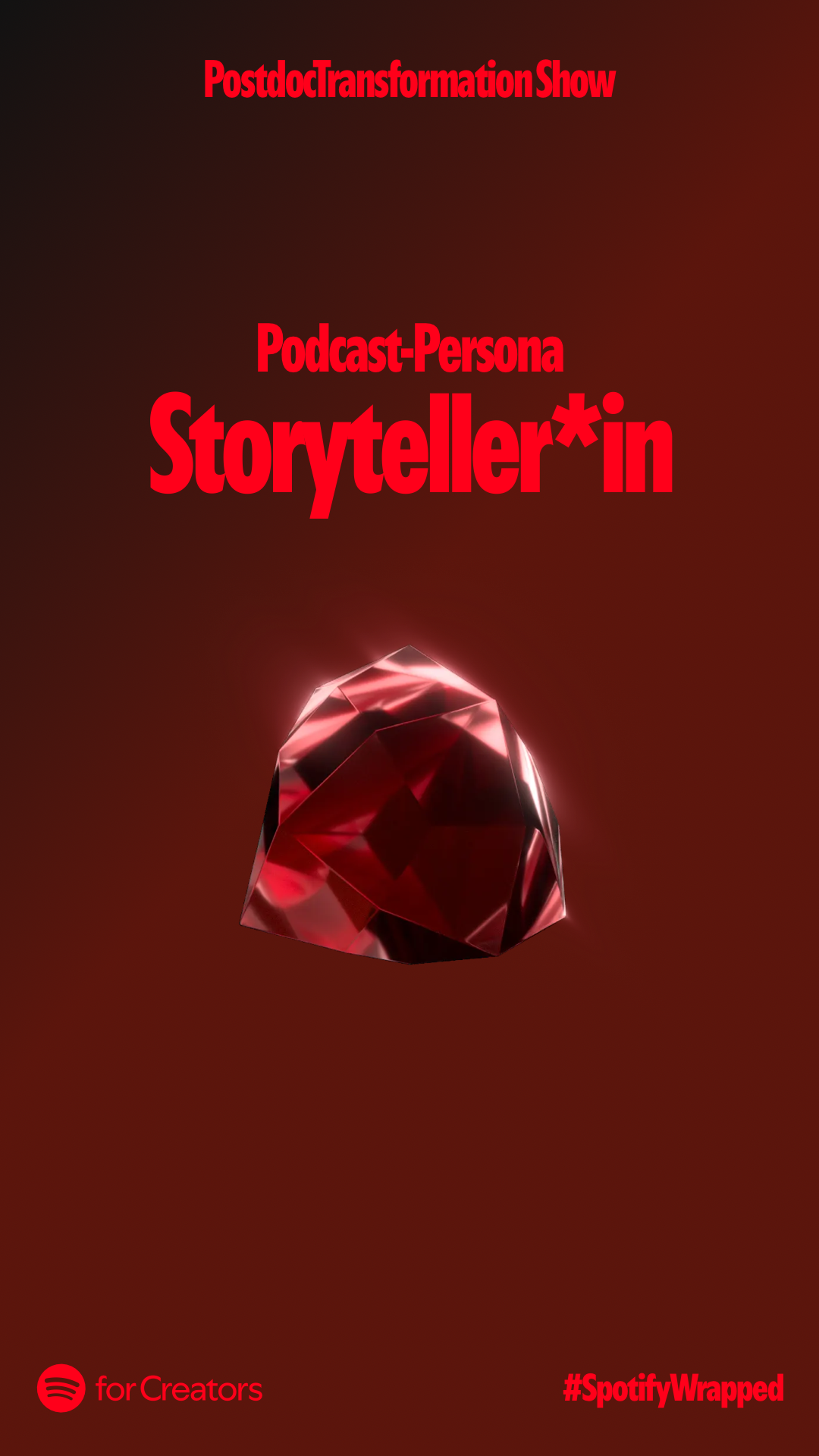
Social selling
And to this point: my social selling index on LinkedIn (connect with me, and if you mention #CreatingReorganized, that will make my day, yeah) is top 1% in the ranking with comparable professors (and business owners) because these are the two current positions in my LinkedIn bio.
I’m ranked in the top 18-21% (it changes weekly) in my LinkedIn community, which is super cool, as I have many TopVoices with many followers as first contacts, making it a challenging competition for me.
Social selling leaders get more opportunities, reach more quota, and sell more than peers with lower SSI that is, who don’t use social media to promote their service and products on social media.
But as founders and business owners, we primarily do business and can’t live on social media, right?
The good news here is: You must invest your time to record your business brand face and voice.
Everything else before and after can be outsourced and enhanced by software.
Check, which assets you want to produce consistently, so that you commit to them. With only two hands you can’t reap all low hanging fruits of a tree.

Consider buying the right podcasting hardware and software.
Check on your social work environment. Assuming that you keep working on your business otherwise, you won’t be feeling lonely podcasting, as this won’t be your only thing. But you can collaborate with business partners left and right, below and above in your supply chain and collaborate with your super fans.
Set your quality standards and then work to honor your standards.
You can choose to do less, but you should maintain your quality as this speaks for your business.
And last but not least, you should be strategic and skilled enough to outsource as needed.
After all, your business promotional podcast can be your most powerful function of your business, but it’s certainly not the only one.
So, there you have it—a roadmap to qualify your podcast listeners with tracking which episodes were listened to, inviting them to benefit from your lead magnets, and convert them into paying customers. Remember, the key is consistency and authenticity.
You don’t need to sell to everyone. Speak to the ones who truly need your solution. Be generous to the ones, who cannot afford yet to buy your services or products, as they will be grateful recommenders or super fans sharing your mission. Build trust, provide value, and guide them toward taking that next step with you.
And if you’re ready to start qualifying your listeners and growing your business promotional podcast, check out the tools I recommend in the show notes: Podbean, Descript, Typeform, ActiveCampaign, Thinkific and Metricool. They’ve been game-changers for me, and I know they’ll help you too.
Thank you for listening to CreatingReorganized! If you found this episode helpful, please subscribe, share it with a business friend, and leave a review on your favorite podcast player. Your feedback helps me as a small business owner to serve more small business owners for free, so thank you and
Happy CreatingReorganized—according to your vision of life!
Cheers, Eleonore & Team PostdocTransformation & CreatingReorganized
